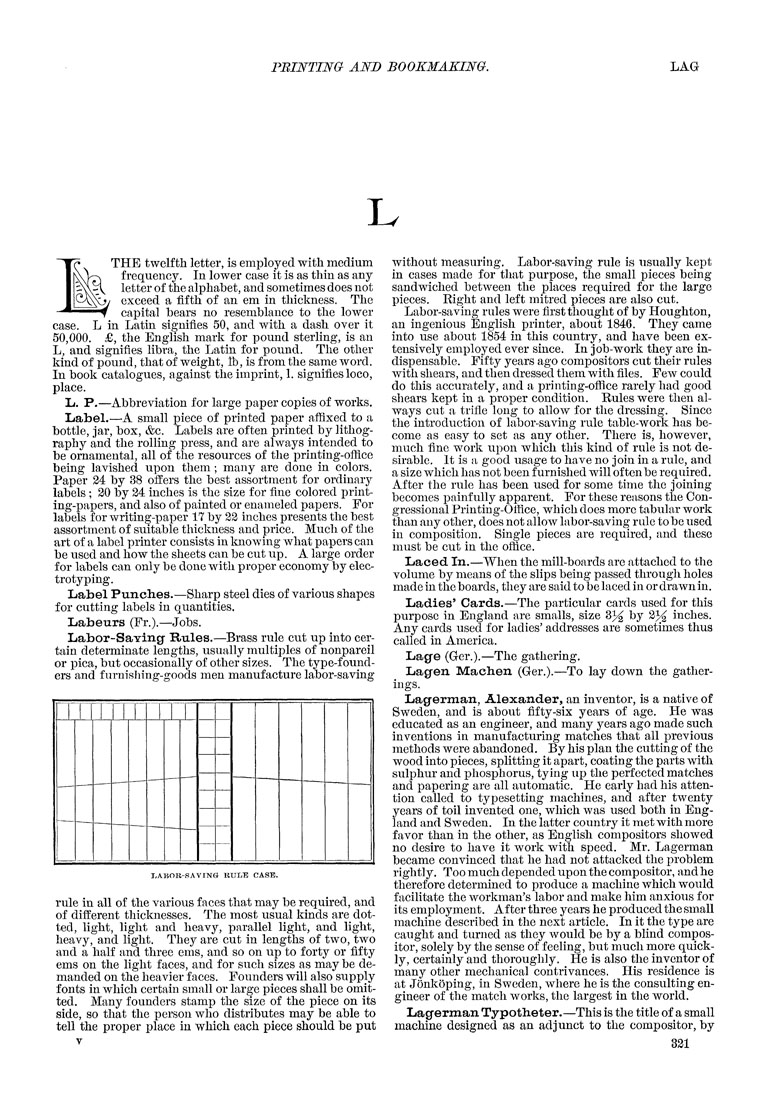PRINTING AND BOOKMAKING.
LAG
L
THE twelfth letter, is employed with medium
frequency. In lower case it is as thin as any
letter of the alphabet, and sometimes does not
exceed a fifth of an em in thickness. The
capital bears no resemblance to the lower
case, L in Latin signifies 50, and with a dash over it
50,000, £, the English mark for pound sterling, is an
L, and signifies libra, the Latin for pound. The other
kind of pound, that of weight, lb, is from the same word.
In book catalogues, against the imprint, 1, signifies loco,
place,
L. P.—Abbreviation for large paper copies of works.
Label.—A small piece of printed paper affixed to a
bottle, jar, box, &c. Labels are often printed by lithog¬
raphy and the rolling press, and are always intended to
be ornamental, all of the resources of the printing-office
being lavished upon them ; many are done in colors.
Paper 24 by 38 offers the best assortment for ordinary
labels ; 20 by 24 inches is the size for fine colored print¬
ing-papers, and also of painted or enameled papers. For
labels for writing-paper 17 by 22 inches presents the best
assortment of suitable thickness and price. Much of the
art of a label printer consists in knowing what papers can
be used and how the sheets can be cut up. A large order
for labels can only be done with proper economy by elec¬
trotyping.
Label Punches.—Sharp steel dies of various shapes
for cutting labels in quantities.
Labours (Fr.).—Jobs.
Lab or-Saving Rules.—Brass rule cut up into cer¬
tain determinate lengths, usually multiples of nonpareil
or iDica, but occasionally of other sizes. The type-found¬
ers and furnisliing-goods men manufacture labor-saving
LABOR-SAVING RULE CASE.
rule in all of the various faces that may be required, and
of different thicknesses. The most usual kinds are dot¬
ted, light, light and heavy, parallel light, and light,
heavy, and light. They are cut in lengths of two, two
and a half and three ems, and so on up to forty or fifty
ems on the light faces, and for such sizes as may be de¬
manded on the heavier faces. Founders will also supply
fonts in which certain small or large pieces shall be omit¬
ted. Many founders stamp the size of the piece on its
side, so that the person who distributes may be able to
tell the proper place in which each piece should be put
without measuring. Labor-saving rule is usually kept
in cases made for that purpose, the small pieces being
sandwiched between the places required for the large
pieces. Right and left mitred pieces are also cut.
Labor-saving rules were first thought of by Houghton,
an ingenious English printer, about 1846. They came
into use about 1854 in this country, and have been ex¬
tensively employed ever since. In job-work they are in¬
dispensable. Fifty years ago compositors cut their rules
with shears, and then dressed them with files. Few could
do this accurately, and a printing-office rarely had good
shears kept in a proper condition. Rules were then al¬
ways cut a trifle long to allow for the dressing. Since
the introduction of labor-saving rule table-work has be¬
come as easy to set as any other. There is, however,
much fine work upon which this kind of rule is not de¬
sirable. It is a good usage to have no join in a rule, and
a size which has not been furnished will often be required.
After the rule has been used for some time the joining
becomes painfully apparent. For these reasons the Con¬
gressional Printing-Office, which does more tabular work
than any other, does not allow labor-saving rule to be used
in composition. Single pieces are required, and these
must be cut in the office.
Laced In.—When the mill-boards are attached to the
volume by means of the slips being passed through holes
made in the boards, they are said to be laced in or drawn in.
Ladies' Cards.—The particular cards used for this
purpose in England are smalls, size 3J^ by 23^ inches.
Any cards used for ladies' addresses are sometimes thus
called in America.
Lage (Ger.).—The gathering.
Lagen Machen (Ger.).—To lay down the gather¬
ings.
Lagerman, Alexander, an inventor, is a native of
Sweden, and is about fifty-six years of age. He was
educated as an engineer, and many years ago made such
inventions in manufacturing matches that all previous
methods were abandoned. By his plan the cutting of the
wood into pieces, splitting it apart, coating the parts with
sulphur and phosphorus, tying up the perfected matches
and papering are all automatic. He early had his atten¬
tion called to typesetting machines, and after twenty
years of toil invented one, which was used both in Eng¬
land and Sweden, In the latter country it met with more
favor than in the other, as English compositors showed
no desire to have it work with speed. Mr, Lagerman
became convinced that he had not attacked the problem
rightly. Too much depended upon the compositor, and he
therefore determined to produce a machine which would
facilitate the workman's labor and make him anxious for
its employment. After three years he produced the small
machine described in the next article. In it the type are
caught and turned as they would be by a blind compos¬
itor, solely by the sense of feeling, but much more quick¬
ly, certainly and thoroughly. He is also the inventor of
many other mechanical contrivances. His residence is
at Jonkoping, in Sweden, where he is the consulting en¬
gineer of the match works, the largest in the world.
Lagerman Typotheter.—This is the title of a small
machine designed as an adjunct to the compositor, by
321
|








